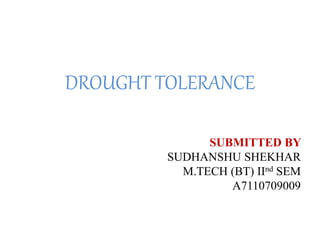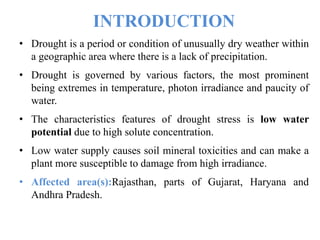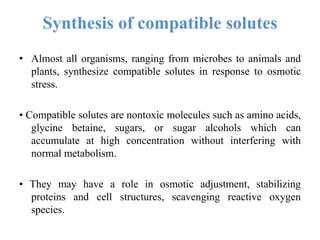Drought Tolerance Agri Ppt
- 1. DROUGHT TOLERANCE SUBMITTED BY SUDHANSHU SHEKHAR M.TECH (BT) IInd SEM A7110709009
- 2. INTRODUCTION ŌĆó Drought is a period or condition of unusually dry weather within a geographic area where there is a lack of precipitation. ŌĆó Drought is governed by various factors, the most prominent being extremes in temperature, photon irradiance and paucity of water. ŌĆó The characteristics features of drought stress is low water potential due to high solute concentration. ŌĆó Low water supply causes soil mineral toxicities and can make a plant more susceptible to damage from high irradiance. ŌĆó Affected area(s):Rajasthan, parts of Gujarat, Haryana and Andhra Pradesh.
- 3. MECHANISM OF DROUGHT TOLERANCE ŌĆó DROUGHT ESCAPE: It is defined as the ability of a plant to complete its life cycle before supply of water in soil is depleted and form dormant seeds before the onset of dry season. These plants are known as drought escapers since they escape drought by rapid development. ŌĆó DROUGHT AVOIDANCE: It is the ability of plants to maintain relatively high tissue- water potential despite a shortage of soil- moisture. Drought avoidance is performed by maintenance of turgor through roots grow deeper in the soil, stomatal control of transpiration and by reduction of water loss through reduced epidermal i.e. reduced surface by smaller and thicker leaves. ŌĆó DROUGHT TOLERANCE: It is the ability to withstand water- deficit with low tissue water potential. Drought tolerance is the maintenance of turgor through osmotic adjustment (a process which induces solute accumulation in cell), increase in elasticity in the cell and decrease in cell size.
- 4. Figure: Drought Avoidance : Reduced surface by smaller and thicker leaves
- 5. Mechanisms of resistance to drought and the methods to increase the resistance 1. Morphology: Increase in water absorption and transportation, declination of transpiration a. Developed root system and higher ratio of root to shoot. b. Thick leaf, smaller leaf area and thick cuticle c. Developed veins and bundle’╝īsmaller and more stomata 2. Physiology and biochemistry: a. Stomatal regulation: ABA accumulationŌåÆstomatal closure b. Increase in capacity of resistance to dehydration of cytoplasm: Rapid accumulation of Pro, glycinebetaine, Lea protein, dehydrin, osmotins and ion etc.
- 6. EFFECT OF DROUGHT STRESS ŌĆó Effect on Growth: Reduction in Turgor Pressure, due to cell sizes will be smaller. ŌĆó Effect on Photosynthesis: Photosynthesis decreases due to disruption of PS II (Photo System II), stomatal closure, decrease in electron transport. ŌĆó Decrease in nuclear acids and proteins: Protease activityŌåæ, free aaŌåæ, RNAase activityŌåæ’╝īRNA hydrolysis, DNA content falls down. ŌĆó Effect on Nitrogen Metabolism: Nitrate reductase activityŌåō, nitrite reductase activity insensitive ŌĆó Effect on Carbohydrate metabolism: Loss of starch and increase in simple sugars, carbohydrate translocation decreases.
- 7. Synthesis of compatible solutes ŌĆó Almost all organisms, ranging from microbes to animals and plants, synthesize compatible solutes in response to osmotic stress. ŌĆó Compatible solutes are nontoxic molecules such as amino acids, glycine betaine, sugars, or sugar alcohols which can accumulate at high concentration without interfering with normal metabolism. ŌĆó They may have a role in osmotic adjustment, stabilizing proteins and cell structures, scavenging reactive oxygen species.
- 8. ŌĆó Proline is the most widely distributed osmolyte; it occurs in plant and in many other organisms. Its accumulation correlates with tolerance to drought and salt stress. ŌĆó Roles: Osmotic adjustment, membranes protection, a reservoir of nitrogen and carbon source for post stress growth, sink for energy to regulate redox potentials, OHŌĆó scavenger. ŌĆó Synthesis can occurs via two biosyntetic pathways: ’üČ The ornithine dependent, and ’üČ The glutamate dependent (predominant under stress conditions). Proline
- 9. Glycine Betaine(GlyBet) Glycine betaine is a quaternary ammonium compound that functions as an osmoprotectant. Its functions include: ’üČ Protects plant by stabilizing both the highly ordered quaternary structure of proteins and membranes. ’üČ Refolding of enzymes as a molecular chaperone. ’üČ Maintenance of the water balance between the plant cell and the environment and by stabilizing macromolecules. ’üČ Glycine betaine is synthesized via a two-step oxidation of choline: CholineŌåÆbetaine aldehydeŌåÆ glycine betaine. The first reaction is catalyzed by a ferredoxin-dependent choline monooxygenase (CMO) and the second step by a NAD+- dependent betaine aldehyde dehydrogenase (BADH).
- 10. Osmolytes, polypeptides and other compounds induced during abiotic drought stresses ŌĆó Polyamines : Spermine, Spermidine, Putrescine, Cadaverine ŌĆó Sugars : Sucrose, Trehalose, Fructans ŌĆó Polyols : Mannitol, Sorbitol, myo-inositol, pinitol (Sugar alcohols) ŌĆó Amino Acids : Proline, Ectoine ŌĆó Quarternary amines : Glycine betaine (GlyBet), Proline betaine, Alanine betaine, 4-hydroxy proline betaine ŌĆó Ions : Potassium ŌĆó Proteins : LEA/dehydrins, SOD/catalase, PR proteins ŌĆó Pigments : Anthocyanins, Betalines, Carotenoids
- 11. Late Embryogenesis Abundant (LEA) Protein ŌĆó Lea genes encode a diverse group of stress-protection proteins expressed during embryo maturation in all angiosperms. ŌĆó Accumulation of LEA proteins during embryogenesis correlates with increased levels of ABA and with acquisition of desiccation tolerance. ŌĆó LEA proteins are not normally expressed in vegetative tissues but they are induced by osmotic stress or exogenous application of ABA. ŌĆó Evidence derived from expression profiles strongly supports a role for LEA proteins as protective molecules, which enable the cells to survive protoplasmic water depletion.
- 12. Engineering drought tolerance using transcription factors (TFs) ŌĆó Conventional and transcriptome-based analyses have revealed that dozens of transcription factors (TFs) are involved in plant response to drought stress. ŌĆó These TFs are categorizes into large gene families like AP2/ERF, bZIP, NAC, MYB, MYC, Cys2His2 zinc-finger and WRKY. ŌĆó TFs regulates downstream genes which acting as a cis-elements more directly act on drought response. ŌĆó Regulation pathways: ’üČ ABA-dependent: ABF/AREB TFs, acting on genes carrying the ABRE element. ’üČ ABA-independent: CBF/DREB TFs acting on genes carrying the CRT/DRE ŌĆōC repeat/dehydration responsive-elements.
- 13. Transcriptional regulatory networks (cis-acting elements and transcription factors) involved in osmotic and cold-stress responsiveness in Arabidopsis
- 14. Strategies for the genetic engineering of drought tolerance
- 15. THANK YOU














